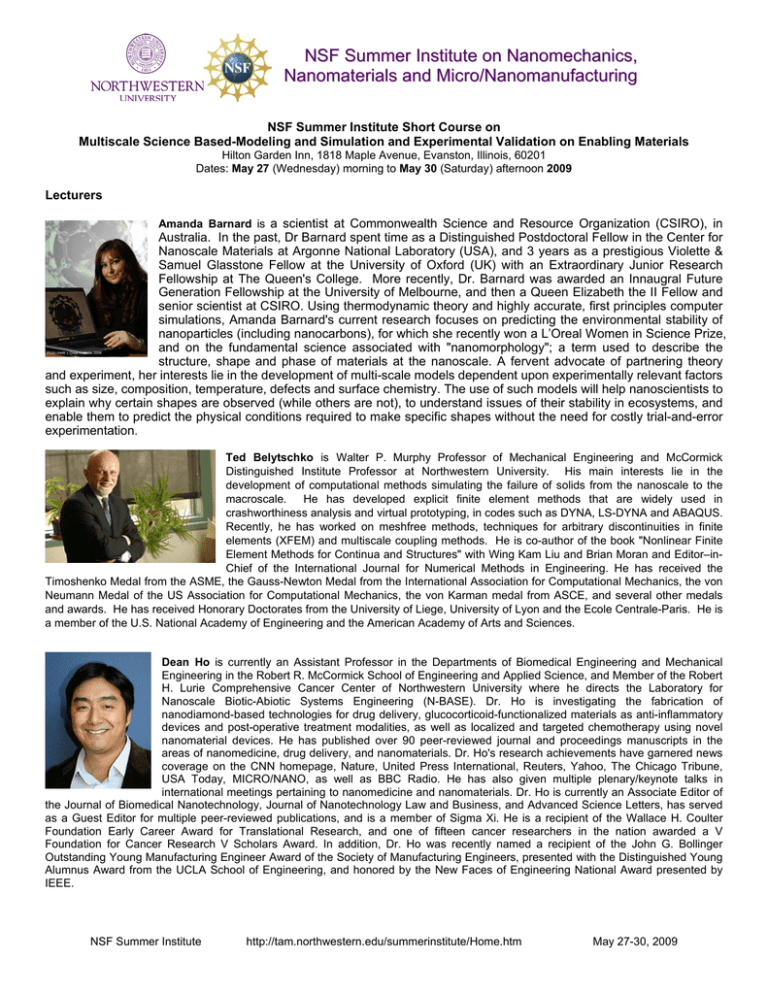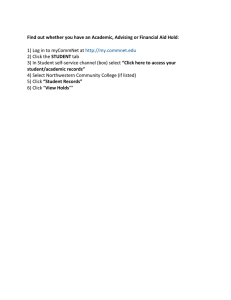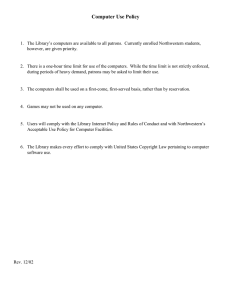N S F
advertisement

NSF Summer Institute on Nanomechanics, Nanomaterials and Micro/Nanomanufacturing NSF Summer Institute Short Course on Multiscale Science Based-Modeling and Simulation and Experimental Validation on Enabling Materials Hilton Garden Inn, 1818 Maple Avenue, Evanston, Illinois, 60201 Dates: May 27 (Wednesday) morning to May 30 (Saturday) afternoon 2009 Lecturers Amanda Barnard is a scientist at Commonwealth Science and Resource Organization (CSIRO), in Australia. In the past, Dr Barnard spent time as a Distinguished Postdoctoral Fellow in the Center for Nanoscale Materials at Argonne National Laboratory (USA), and 3 years as a prestigious Violette & Samuel Glasstone Fellow at the University of Oxford (UK) with an Extraordinary Junior Research Fellowship at The Queen's College. More recently, Dr. Barnard was awarded an Innaugral Future Generation Fellowship at the University of Melbourne, and then a Queen Elizabeth the II Fellow and senior scientist at CSIRO. Using thermodynamic theory and highly accurate, first principles computer simulations, Amanda Barnard's current research focuses on predicting the environmental stability of nanoparticles (including nanocarbons), for which she recently won a L’Oreal Women in Science Prize, and on the fundamental science associated with "nanomorphology"; a term used to describe the structure, shape and phase of materials at the nanoscale. A fervent advocate of partnering theory and experiment, her interests lie in the development of multi-scale models dependent upon experimentally relevant factors such as size, composition, temperature, defects and surface chemistry. The use of such models will help nanoscientists to explain why certain shapes are observed (while others are not), to understand issues of their stability in ecosystems, and enable them to predict the physical conditions required to make specific shapes without the need for costly trial-and-error experimentation. Ted Belytschko is Walter P. Murphy Professor of Mechanical Engineering and McCormick Distinguished Institute Professor at Northwestern University. His main interests lie in the development of computational methods simulating the failure of solids from the nanoscale to the macroscale. He has developed explicit finite element methods that are widely used in crashworthiness analysis and virtual prototyping, in codes such as DYNA, LS-DYNA and ABAQUS. Recently, he has worked on meshfree methods, techniques for arbitrary discontinuities in finite elements (XFEM) and multiscale coupling methods. He is co-author of the book "Nonlinear Finite Element Methods for Continua and Structures" with Wing Kam Liu and Brian Moran and Editor–inChief of the International Journal for Numerical Methods in Engineering. He has received the Timoshenko Medal from the ASME, the Gauss-Newton Medal from the International Association for Computational Mechanics, the von Neumann Medal of the US Association for Computational Mechanics, the von Karman medal from ASCE, and several other medals and awards. He has received Honorary Doctorates from the University of Liege, University of Lyon and the Ecole Centrale-Paris. He is a member of the U.S. National Academy of Engineering and the American Academy of Arts and Sciences. Dean Ho is currently an Assistant Professor in the Departments of Biomedical Engineering and Mechanical Engineering in the Robert R. McCormick School of Engineering and Applied Science, and Member of the Robert H. Lurie Comprehensive Cancer Center of Northwestern University where he directs the Laboratory for Nanoscale Biotic-Abiotic Systems Engineering (N-BASE). Dr. Ho is investigating the fabrication of nanodiamond-based technologies for drug delivery, glucocorticoid-functionalized materials as anti-inflammatory devices and post-operative treatment modalities, as well as localized and targeted chemotherapy using novel nanomaterial devices. He has published over 90 peer-reviewed journal and proceedings manuscripts in the areas of nanomedicine, drug delivery, and nanomaterials. Dr. Ho's research achievements have garnered news coverage on the CNN homepage, Nature, United Press International, Reuters, Yahoo, The Chicago Tribune, USA Today, MICRO/NANO, as well as BBC Radio. He has also given multiple plenary/keynote talks in international meetings pertaining to nanomedicine and nanomaterials. Dr. Ho is currently an Associate Editor of the Journal of Biomedical Nanotechnology, Journal of Nanotechnology Law and Business, and Advanced Science Letters, has served as a Guest Editor for multiple peer-reviewed publications, and is a member of Sigma Xi. He is a recipient of the Wallace H. Coulter Foundation Early Career Award for Translational Research, and one of fifteen cancer researchers in the nation awarded a V Foundation for Cancer Research V Scholars Award. In addition, Dr. Ho was recently named a recipient of the John G. Bollinger Outstanding Young Manufacturing Engineer Award of the Society of Manufacturing Engineers, presented with the Distinguished Young Alumnus Award from the UCLA School of Engineering, and honored by the New Faces of Engineering National Award presented by IEEE. NSF Summer Institute http://tam.northwestern.edu/summerinstitute/Home.htm May 27-30, 2009 NSF Summer Institute on Nanomechanics, Nanomaterials and Micro/Nanomanufacturing Lecturers Wing Kam Liu is Walter P. Murphy Professor of Mechanical Engineering at Northwestern University and Chair of the ASME K&C Nanotechnology Council. He received his B.S. from the University of Illinois at Chicago; his M.S. and Ph.D. both from Caltech. He is a world leader in multiscale simulation-based engineering and science and has applied a spectrum of atomistic, quantum, and continuum strategies towards the understanding of nanomaterial function and biological processes. He was the first to develop concurrent multiscale methods for materials design. These methods have been used to design new alloys and nano-composites. Selected honors include the Robert Henry Thurston Lecture Award, the Gustus L. Larson Memorial Award, the Pi Tau Sigma Gold Medal and the Melville Medal, (all from ASME); the John von Neumann Medal from US Association of Computational Mechanics (USACM); and the Computational Mechanics Awards of the International Association of Computational Mechanics (IACM) and the Japanese Society of Mechanical Engineers. Liu chaired the ASME Applied Mechanics Division and is past president of USACM. He is listed by the Institute for Scientific Information as one of the most highly cited researchers in engineering. He is the editor of two International Journals and honorary editor of two journals and has been a consultant for more than 20 organizations. Liu has written three books, the Finite element book becomes a classical in the field and the Nano Mechanics and Materials book received a very favorable review by Nanotoday (Nov, 2006). Eiji Osawa is the President of NanoCarbon Research Institute Ltd., a private research company for industrialization of fullerenes. Since 1992 he has been the Representative Executive Member of the FullereneNanotube Research Association, a subsidiary of the Chemical Society of Japan. He has been trained as an organic chemist in the Department of Industrial Chemistry of Kyoto University. After earning M. Eng. in chemistry in 1960, he joined Teijin Co., Ltd. as an engineer. In 1964 he returned to his alma mater as a stuff assistant when all the science-engineering departments in Japan and US were doubled in size, a countermeasure against the 'Sputnik shock'. After acquiring D. Eng. in chemistry by thesis he spent three years as a postdoctoral stint in the University of Wisconsin, Princeton University and the State University of New York at Stony Brook, and returned to Japan as an assistant professor of Hokkaido University in 1970. He moved to Toyohashi University of Technology as a full professor in July 1990. At the age of 65, he retired from TUT in 2001, and immediately set up a venture company NanoCarbon Research Institute with the help from Futaba Corporation in Chiba, east of Tokyo. He is known as the first scientist to conceive C60 as the molecule with special aromatic stability in 1970. While he is also one of the earliest computational chemists and most of the work in his earlier carrier has been devoted to applied theoretical chemistry, his main research interests center around fullerenes, ever since this wonder molecule was discovered experimentally in 1985. For the prediction of C60, he was awarded Chu-nichi Culture Prize in 2001. George C. Schatz is Charles E. and Emma H. Morrison Professor of Chemistry at Northwestern University. Degrees include a B. S. at Clarkson University and Ph. D. at Caltech, both in chemistry. He was a postdoc at MIT, and has been at Northwestern since 1976. Schatz has published three books and over 500 papers. Schatz is a member of the National Academy of Sciences, the American Academy of Arts and Sciences, the International Academy of Quantum Molecular Sciences and he is Editor-in-Chief of the Journal of Physical Chemistry. Awards include Sloan and Dreyfus Fellowships, the Fresenius Award of Phi Lambda Upsilon, the Max Planck Research Award and the Bourke Medal of the Royal Society of Chemistry. He is a Fellow of the American Physical Society and of the AAAS. Schatz's research is concerned with theory and computational modeling in a variety of nanoscience topics as well as in related biophysics and materials areas. His nanoscience work has specialized in studies of the optical properties of noble metal nanoparticles, nanoholes in films and other nanostructured materials of relevance to chemical and biological sensing applications. He has contributed to theories of DNA melting of nanoparticle aggregates, and he has studied the phase diagram behavior of nanoscale lipid structures including liposomes and lipoplexes. Schatz has also been involved in a wide variety of theoretical studies involving self-assembly processes, DNA and protein structures, transport in ion-channels, the deposition and patterning of molecules on surfaces, and the formation of water droplets on nanoscale structures. In addition, he has worked actively in the modeling of the mechanical properties of hard materials, including diamond films and carbon nanotubes. NSF Summer Institute http://tam.northwestern.edu/summerinstitute/Home.htm May 27-30, 2009 NSF Summer Institute on Nanomechanics, Nanomaterials and Micro/Nanomanufacturing Course Organization The short course will first cover science-based modeling and simulation methods for general classes of enabling materials. This will be followed by examining more focused applications towards nanocarbons-based strategies as multifunctional materials for sensing, device fabrication, manipulation, medicine, and biology. The short course will be divided into 7 blocks of 4 mornings (8:30am-12:00noon, starts at 8:00am the first day) of 3 hours each and 3 afternoons (1:15pm-5:45pm) of 4 hours each. Each hour is a 50 minute lecture and a 10 minute break. This gives a total of 24 sessions of 50 minutes each. Course Description and Outline Science-Based Modeling and Simulation Methods for General Classes of Enabling Materials (10 hours) Predicting nano/micro-structure-property relationships in engineering materials via direct simulation of the underlying nano/micro-mechanics remains an elusive goal due to the massive disparities in length and time scales; huge structures such as bridges may fail after decades of operation due to microscale fracture events which occur at a micro/nano second time scale. Even as we move into the era of petaflop computing, affordability remains a key factor when developing a sciencebased computational method. In an effort to bypass the limitations of computational speed and storage capacity, scientists and engineers in many fields have focused on multiscale analysis theories. Belytschko, Liu and Schatz will first cover theories and foundations of methods for modeling of general classes of enabling materials at the nano and micro scales, including electronic structure (quantum mechanics), atomistic (potential force field methods), mesoscale and continuum approaches. The basic issues in electronic structure theory, including Hartree-Fock and density functional approaches, plus improvements thereto, will be examined. Some of the implementations of these theories, including Gaussian-orbital and other basis functions, geometry optimization, vibrational frequency calculations, and the calculation of mechanical properties, will be described. Empirical force field approaches will also be covered, including the standard force fields for bio-simulation, and bond-order force fields which can describe bond breaking. Hierarchical and concurrent multiscale coupling method will be described: these include Quantum/continuum coupling methods, such as the ONIOM methods, and molecular/continuum coupling, such as the bridging scale and bridging domain methods for both equilibrium and finite temperature problems The applications of these methods to fracture and modulus calculations for carbon nanotubes, diamond structures, and graphene structures and nano-carbon based materials and polymer composites will be described. Extension to general probabilistic Nano/microstructural continuum theory for multiscale fracture will also be given. The following topics will be covered: • Electronic structure calculations: fundamentals • Electronic structure calculations: methods and applications • Empirical potential methods and applications • Atomistic continuum coupling by bridging domain methods and related models • Cauchy-Born rule and other homogenization methods; loss of ellipticity • Bridging scale and virtual atom cluster multiscale methods • Multiscale modeling of nano/micro composites and alloys • Finite temperature coupling of atomistic/continuum models • Coupled quantum/molecular/continuum applications to strength of nanotubes and grapheme • Nano/micro-structural continuum theory for multiscale materials Focused Application of Nano-Carbons Based Materials for Multifunctional Materials for sensing, device fabrication, manipulation, medicine, and biology (14 hours) Nanocarbons represent a class of emerging materials with unique attributes that can address key requirements in medicine and biology. For example, graphene is being explored as a novel material for electronics/energy applications, as well as multifunctional materials for polymeric nanocomposite synthesis. Furthermore, Nanotubes have found applications in bioelectronics and sensing, and are being explored as platforms for diagnostic imaging agents. Furthermore, nanotube-based devices are being fabricated as nanomaterial-based mimics of gecko-inspired adhesives. In evaluating additional recent focus areas of nanocarbon-driven innovation, nanodiamonds have recently gained significant attention due to their collective properties that confer enormous potential towards their unique applicability as optimized drug delivery platforms. The fruition of nanocarbon systems towards realized relevance as multifunctional materials for sensing/diagnostics, biology, and medicine requires a clear interface between multi-scale simulation/modeling and experimental interrogation of the material properties which contribute to their unique performance capabilities. For example, nanodiamonds possess several unique characteristics that serve as the foundation of their translational potential. NSF Summer Institute http://tam.northwestern.edu/summerinstitute/Home.htm May 27-30, 2009 NSF Summer Institute on Nanomechanics, Nanomaterials and Micro/Nanomanufacturing Nanodiamonds can be scalably produced; batch functionalized, interfaced with nearly any type of therapeutic, is immensely biostable, and has highly-ordered aspect ratios which contribute to their bio-amenability. They are also capable of generating consistent, ‘zero-order’ release profiles. The ability to investigate, understand, and direct the behavior of nanocarbon systems relies upon the marriage of simulation-based and experimental validation. The Summer Institute will address these aspects by bringing together lectures from authorities on multi-scale simulation-based engineering and science, fundamental nanocarbon interrogation, experimental drug delivery, and nanocarbon surface property analysis Barnard, Ho, Liu, Osawa, and Schatz will focus on nanocarbons, in particular, nanodiamond applications to sensing, devices, manipulation, medicine, and biology. The following topics will be covered: • • • • • • • • • • • • • • • • Background on Nanocarbons including fullerenes, nanotubes, nano-onions and nanodiamond. Handling of Nanodiamond including purification, properties of dispersed single-nano diamond particles, Validation Experiments on Colloidal Solution of Nanodiamond. Surface Structure and Crystallinity of Nanodiamond. Defects, impurities and dopants in diamond. Modeling surface chemistry and environmental stability of nanocarbons. Modeling electronic properties of nanocarbons. Nanodiamond particles as functionalized platforms for injectable therapy. Nanodiamond-based film platforms for anti-inflammatory application. Protein-mediated assembly of nanodiamond films for localized release. The integration of nanodiamonds with a broad array of polymeric systems. Applications in breast, liver, and other emerging cancer models. Nanodiamonds and biocompatibility. Translational relevance of nanodiamonds. Chemical functionalization of nanocarbon surfaces, Multiscale modeling of absorption and dissociation of drug molecules on nanocarbon drug delivery devices. Fees The registration fee for the short course is: $2,000. An additional $200 fee will be added to late registrations received after May 1, 2009. Register by March 15, 2009 and receive a 20% discount. The fee includes coffee breaks, and lunches each day as well as all presentation materials, lecture notes and appropriate review papers. NSF fellowships are available to faculty members, high-school science teachers, post-docs and Ph.D. candidates from the US. The fellowship consists of full registration fee plus an accommodation allowance. Download the application form from http://tam.northwestern.edu/summerinstitute/Home.htm. The deadline for fellowship application is March 1, 2009. Location The course will be held at Hilton Garden Inn, 1818 Maple Avenue, Evanston, Illinois, 60201. Accommodations A block of rooms has been reserved at special rates for short course attendees at the Hilton Garden Inn. Attendees should contact the hotel directly to make reservations by calling 847-475-6400 or through 1-877-STAY HGI or 1-800-HILTONS, to qualify for special rates guests must mention "NSF Summer Institute on Science Based Simulation". The rooms at the special rate of $132 will only be held until April 15, 2009. Registration Registration form can be downloaded from http://tam.northwestern.edu/summerinstitute/Home.htm. Mail in the completed registration form with check or money order by March 1, 2009. Make check or money order payable to: Northwestern University Send to: Northwestern University, Dept. of Materials Science and Engineering, 2145 Sheridan Road, Evanston, Illinois, 60208 Attn: Yip Wah Chung For additional information, contact: http://tam.northwestern.edu/summerinstitute/Home.htm email : summerinstitute@mail.mech.northwestern.edu NSF Summer Institute http://tam.northwestern.edu/summerinstitute/Home.htm May 27-30, 2009






